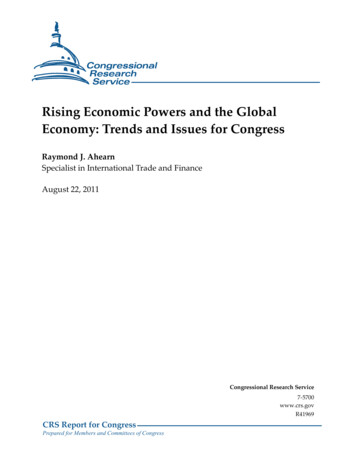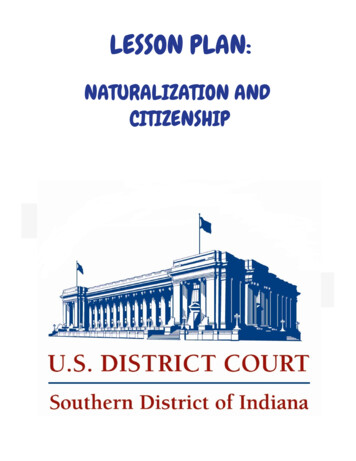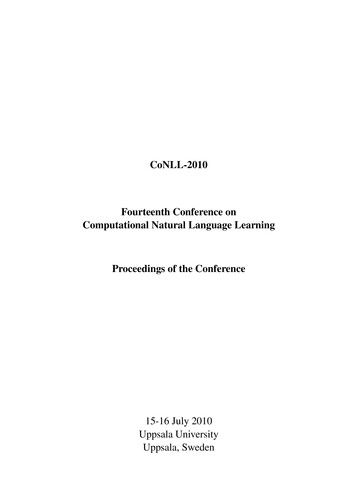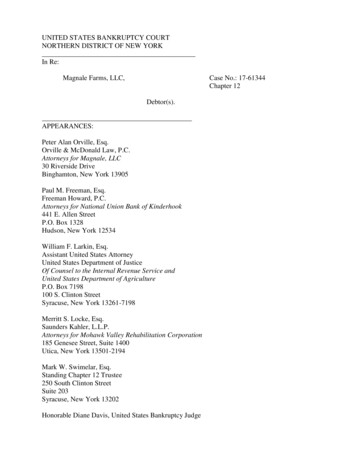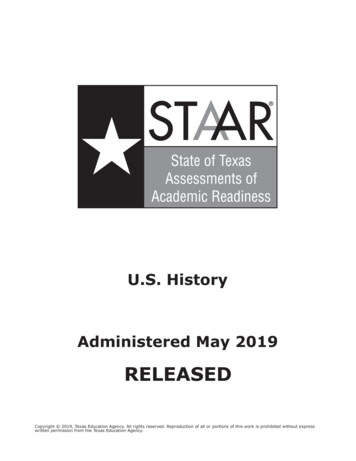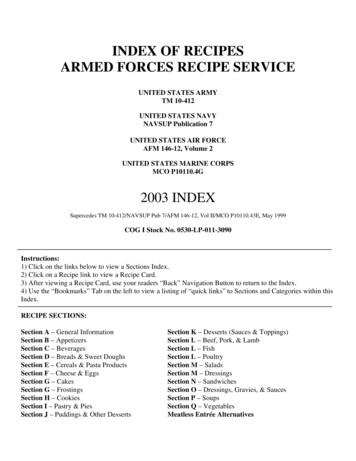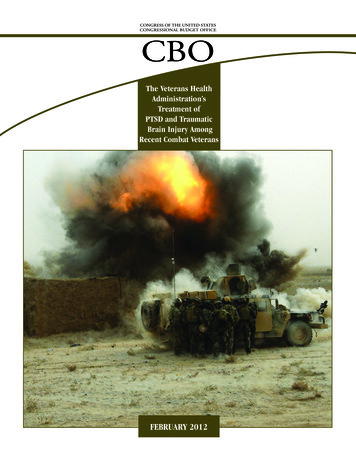
Transcription
CONGRESS OF THE UNITED STATESCONGRESSIONAL BUDGET OFFICECBOThe Veterans HealthAdministration’sTreatment ofPTSD and TraumaticBrain Injury AmongRecent Combat VeteransFEBRUARY 2012
Pub. No. 4097
ACBOS T U D YThe Veterans Health Administration’sTreatment of PTSD and Traumatic BrainInjury Among Recent Combat VeteransFebruary 2012The Congress of the United States O Congressional Budget Office
NotesUnless otherwise indicated, all years referred to in this study are federal fiscal years (which runfrom October 1 to September 30).Unless otherwise indicated, all dollar amounts in this study are expressed in 2011 dollars.Before providing cost data to the Congressional Budget Office (CBO), the Veterans HealthAdministration converted those data to fiscal year 2009 dollars on the basis of annualincreases in the average cost of a primary care visit from 2004 to 2009. CBO indexed thosedata to 2011 dollars using the implicit price deflator for gross domestic product. CBO alsoconverted other dollar amounts reported in this study to 2011 dollars using the implicit pricedeflator for gross domestic product.Numbers in the text and tables may not add up to totals because of rounding.CBO
PrefaceTwo combat-related conditions that affect some veterans who have served in Iraq andAfghanistan and that have generated widespread concern among policymakers are posttraumatic stress disorder (PTSD) and traumatic brain injury (TBI). In response to a requestfrom the Ranking Member of the House Committee on Veterans’ Affairs, this CongressionalBudget Office (CBO) study examines the following: The clinical care that the Veterans Health Administration (VHA), the health caresystem within the Department of Veterans Affairs, provides for recent combat veterans; VHA’s coordination with the Department of Defense for the care of service membersreturning from Iraq and Afghanistan; The prevalence of PTSD and TBI among veterans of those conflicts and the occurrenceof those conditions among recent combat veterans using VHA’s services; and The costs to VHA of providing care to recent combat veterans for those conditions.In keeping with CBO’s mandate to provide objective, impartial analysis, this study makes norecommendations.Elizabeth Bass and Heidi Golding of CBO’s National Security Division prepared the studyunder the general supervision of David Mosher and Matthew Goldberg. Allison Percyserved as the internal reviewer. Lindsay Coleman, Juan Contreras, Sunita D’Monte, andAnn Futrell provided thoughtful comments on a draft of the study, as did external reviewerRajeev Ramchand of RAND Corporation. (The assistance of an external reviewer impliesno responsibility for the final product, which rests solely with CBO.) Adebayo Adedeji factchecked the manuscript. The authors wish to thank the Department of Veterans Affairs andthe Department of Defense for providing data used in the analysis.Juyne Linger edited the study, and John Skeen proofread it. Cindy Cleveland produced draftsof the manuscript. Maureen Costantino prepared the paper for publication and designed thecover. Monte Ruffin printed the initial copies, and Linda Schimmel handled the print distribution. The publication is available at CBO’s Web site (www.cbo.gov).Douglas W. ElmendorfDirectorFebruary 2012CBO
ContentsSummaryviiIntroduction1Clinical Care Within VHA3VHA’s Services for PTSD3VHA’s Services for TBI5Concurrent Diagnoses of PTSD and TBI6Polytrauma6Cooperation Between VHA and DoD7CBO’s Analytical Approach to VHA Data8Occurrence and Prevalence of PTSD and TBI10Use of VHA’s Services12Number of Patients Using VHA’s Services14Frequency of Use15Costs of VHA’s Services16Costs of All Health Care17Costs of PTSD- and TBI-Specific Care18Other Studies of the Costs of Treating PTSD and TBI20Polytrauma Patients21Appendix A: Background on PTSD and TBI23Appendix B: Data and Methods27Appendix C: Interpreting Published Estimates of the Prevalence of PTSD and TBI31Appendix D: VHA’s Average Annual Costs for OCO Veterans Who Continue toSeek Care37CBO
VITHE VETERANS HEALTH ADMINISTRATION’S TREATMENT OF PTSD AND TRAUMATIC BRAIN INJURY AMONG RECENT COMBAT VETERANSTablesS-1. The First Year of Treatment for All Health Care Provided toOCO Patients by VHAviii1. Total Costs for VHA’s Health Care Provided to OCO Patients182. Average Costs for All of VHA’s Health Care and VHA’s PTSD- andTBI-Specific Care Provided to OCO Patients193. Use and Costs of VHA’s Health Care Provided to OCOPolytrauma Patients22D-1. Sample Sizes38D-2. Alternative Calculation of Average Costs for All of VHA’s Health CareProvided to OCO Patients39Figures1. Continuation of Use of VHA’s Services by OCO Veterans142. Use of VHA’s Health Care Services by OCO Patients153. Average Costs for All of VHA’s Health Care Provided to OCO Patients20B-1. Years of Potential Use of VHA’s Services, by OCO Patient’s Year of Entry28Boxes1. Eligibility for VHA’s Services2. Suicide and Mental Illness Among OCO VeteransCBO212
SummaryMore than 2 million service members havedeployed in support of overseas contingency operations(OCO) in Iraq and Afghanistan since October 2001.Some military service members receive medical care inthe combat theater for injuries or other medical conditions sustained while deployed. Other service membershave combat-related medical conditions that are identified and treated after they return from war—within theDepartment of Defense’s (DoD’s) health care system foractive-duty personnel and within the Department ofVeterans Affairs (VA) for veterans, including deactivatedreservists. VA provides health care services through theVeterans Health Administration (VHA), which treatsveterans for service-connected conditions and otherconditions.VHA spent about 2 billion (in 2011 dollars) in fiscalyear 2010 to treat veterans of recent overseas contingencyoperations, compared with total expenditures in 2010 onhealth care for veterans of all eras and conflicts of about 48 billion. From 2002 through 2010, VHA spent a totalof 6 billion on health care expenditures for recent OCOveterans.Two conditions that affect some military servicemembers during deployment to a combat theater andafterward are post-traumatic stress disorder (PTSD) andtraumatic brain injury (TBI). PTSD is an anxiety disorder induced by exposure to a traumatic event, such aswitnessing injury or death. It is characterized by symptoms that include reexperiencing the event, hyperarousal(irritability, anger, or hypervigilance, for example), anddiminished responsiveness to or avoidance of stimuliassociated with the trauma.TBI is caused by sudden trauma to the head and is commonly sustained by soldiers exposed to explosions. It mayresult in a decreased level of consciousness, amnesia, orneurological abnormalities, and it is classified as mild,moderate, or severe on the basis of its severity at the timeof the injury. Mild TBI, which is also known as a concussion, may in some cases lead to ongoing symptoms thatinclude headaches, memory difficulties, fatigue, irritability, and sleep problems. Diagnosing severe cases isstraightforward, but mild TBIs—which account forabout 90 percent of TBI cases among active-duty OCOservice members—may be difficult to detect, both bythose afflicted and by health care professionals, althoughmost cases resolve quickly without medical intervention.1Some observers contend that DoD and VHA may notadequately screen, diagnose, and treat OCO servicemembers and veterans affected by PTSD and mild TBI.In this study, the Congressional Budget Office (CBO)analyzes VHA’s care of OCO patients diagnosed withPTSD or TBI and compares the reported rates of occurrence of those conditions within VHA with estimates ofthe prevalence of those conditions in the broader population of service members who have deployed to recentoverseas contingency operations. (Prevalence estimatesgauge the proportion of cases of a disease or condition ina population, whether or not people have received a diagnosis from a medical professional; by comparison, thereported occurrence of conditions among the peoplewho have been treated within VHA reflects counts ofdiagnoses by medical professionals.) The study also examines the costs that VHA has incurred in treating patientsdiagnosed with PTSD and TBI.1. Diagnosis of mild TBI with persistent symptoms is complicatedbecause the condition does not have a clinically validated definition—that is, a definition that is based on a substantive body ofempirical research and is broadly accepted by the medical community. Moreover, many other conditions cause symptoms that aresimilar to those of mild TBI.CBO
VIIITHE VETERANS HEALTH ADMINISTRATION’S TREATMENT OF PTSD AND TRAUMATIC BRAIN INJURY AMONG RECENT COMBAT VETERANSSummary Table 1.The First Year of Treatment for All Health Care Provided toOCO Patients by VHATreatment GroupPTSD or TBIPTSDaTBIbBoth PTSD and TBINo PTSD or TBIPolytraumaAverage Costper Patient(Dollars)Number ofOCO PatientsShare of AllOCO 0021252,400358,00072136,000500*Source: Congressional Budget Office based on data from the Department of Veterans Affairs, Veterans Health Administration.Notes: Data cover fiscal years 2004 to 2009 for the first year of treatment.All of the TBI patients in the data that CBO examined had symptomatic TBI—that is, they exhibited symptoms that were attributed toTBI at the time of VHA’s medical screening or examination.VHA converted costs provided to CBO to fiscal year 2009 dollars on the basis of annual increases in the average cost of a primary carevisit from 2004 to 2009. CBO then indexed those costs to 2011 dollars using the implicit price deflator for gross domestic product.OCO overseas contingency operations; VHA Veterans Health Administration; PTSD post-traumatic stress disorder;TBI traumatic brain injury; * less than 1 percent.a. Patients in the PTSD group did not have TBI, but many had other conditions.b. Patients in the TBI group did not have PTSD, but many had other conditions.In brief, CBO finds: Among OCO patients treated by VHA from 2004through 2009, 21 percent were diagnosed with PTSD(but not TBI) and 2 percent with symptomatic TBI(but not PTSD) (see Summary Table 1).2 An additional 5 percent had both PTSD and TBI; thus, about75 percent of those diagnosed with TBI had a concurrent diagnosis of PTSD. Seventy-two percent ofpatients had neither diagnosis. (CBO separatelyanalyzed another 500 polytrauma patients—that is,ones with complex, severe injuries to multiple organsystems.) The average cost for OCO patients in the first year oftheir treatment was about four to six times greater forpatients with a diagnosis of PTSD, TBI, or both thanfor patients without those conditions.2. All of the TBI patients in the data that CBO examined hadsymptomatic TBI—that is, they exhibited symptoms that wereattributed to TBI at the time of VHA’s medical screening or examination.CBO VHA’s average costs for OCO patients were highestduring the first year of care and generally declined andthen stabilized in subsequent years. For patients with TBI (including those with bothPTSD and TBI), however, VHA’s average treatmentcosts appear to increase in the third and fourth years ofcare. That result is probably driven by a policy changethat occurred in the middle of the period that CBOanalyzed and the nature of the data that VHA provided to CBO.3 In the absence of the policy change,3. VHA’s clinical practices for TBI changed during the data period(2004 to 2009): In 2007, the agency initiated comprehensivescreening for mild, symptomatic TBI. Therefore, patients whomVHA diagnosed with TBI in 2007 or later were more likely tohave had mild TBI than those diagnosed before that year. As aresult, the data that CBO analyzed included a smaller share ofpatients with mild TBI in their third and fourth years of treatment than in their first and second years. Because treating patientswith moderate or severe TBI requires more extensive services andresources than does treating patients with mild TBI, that difference elevated the estimated average costs of treatment for TBIpatients in the third and fourth years.
SUMMARYTHE VETERANS HEALTH ADMINISTRATION’S TREATMENT OF PTSD AND TRAUMATIC BRAIN INJURY AMONG RECENT COMBAT VETERANScosts for those patients probably also would have beenhighest during the first year of care and then declinedand stabilized thereafter. A great deal of uncertainty surrounds the prevalence ofPTSD and TBI within the OCO population and,hence, the number of veterans with those conditionsthat DoD, VHA, and other health care providers mayencounter in the future.Projecting the future costs of treating veterans withPTSD and TBI requires estimating both the numberof patients with those conditions who will seek VHA’scare and the costs per patient that VHA will incur.Because the research community has not reached a consensus about the prevalence of those conditions, suchprojections would be highly uncertain. CBO examinedpublished studies that reported the prevalence of PTSDor TBI among different groups of service members orveterans who had deployed to overseas contingencyoperations. For PTSD, those prevalence estimates havegenerally ranged between 5 percent and 25 percent. ForTBI, those estimates indicate that between 15 percentand 23 percent of service members may have experienceda TBI while deployed to an overseas contingency operation but that a smaller share, between 4 percent and9 percent, are still symptomatic when screened afterreturning to the United States. Estimates of the preva-IXlence of PTSD and TBI vary widely among studiesbecause of substantial differences in the assessment toolsthat researchers use to identify the conditions, the stringency of the criteria they employ, and the subgroupsthey sample. The percentage of OCO veterans whomVHA clinicians have diagnosed with PTSD (26 percent)is at the top of the range reported in published studies,whereas the percentage they have diagnosed with symptomatic TBI (7 percent) is in the middle of thereported range.The rates of diagnosis of PTSD and TBI among OCOveterans seeking treatment at VHA do not necessarilyreflect the prevalence of those conditions in the entireOCO population. If veterans who suspected they hadmental health or other medical problems were more likelythan other veterans to seek medical care from VHA, therates of PTSD and TBI diagnosed among VHA’s patientswould tend to overestimate the prevalence in the entireOCO population. However, some veterans might notseek care from VHA for various reasons—the stigmaassociated with having a mental health problem, forexample, or the inconvenience of undergoing additionalevaluation and treatment. If a sufficient number of veterans with PTSD and TBI did not seek care from VHA,the rates of diagnoses for those conditions among VHA’spatients would tend to underestimate the prevalence inthe OCO population.CBO
The Veterans Health Administration’s Treatment ofPTSD and Traumatic Brain Injury AmongRecent Combat VeteransIntroductionThe United States has been involved in overseas contingency operations (OCO) in Afghanistan and Iraq sinceOctober 2001 and March 2003, respectively, and hasdeployed more than 2 million service members in support of those operations. The Department of Defense(DoD) delivers medical care to service members whilethey are deployed. That care includes nearly 4 millionmedical encounters since January 2005 for a variety ofconditions, including injuries; it also includes 71,000medical evacuations of service members from the combattheaters through November 2011. Both DoD and theVeterans Health Administration (VHA), the organizationthat provides medical care within the Department ofVeteran Affairs (VA), screen for various conditions andprovide health care after service members return fromdeployment. VHA treated 400,000 (31 percent) of1.3 million eligible OCO veterans in fiscal year 2010,up from 100,000 (20 percent) of 500,000 eligible OCOveterans in 2005. Many eligible veterans do not seek careat VHA in any given year or at any time, and most VHApatients seek additional health care outside of VHA. (SeeBox 1 for information about eligibility for VHA’s healthcare system.) Although OCO veterans made up 7 percentof the patients VHA treated in 2010, they accounted foronly 4 percent ( 2 billion) of the 48 billion (in 2011dollars) that VHA obligated for medical care that year.From 2002 through 2010, VHA spent a total of 6 billion on health care for OCO veterans.1Two medical conditions that may affect OCO veteranshave received particular attention: post-traumatic stressdisorder (PTSD) and traumatic brain injury (TBI).PTSD is an anxiety disorder triggered by a traumaticevent, such as may occur when engaging in combat;witnessing serious injury, brutality, or unnatural death,particularly of another soldier; or suffering a severevehicle accident, including those caused by improvisedexplosive devices (IEDs). The symptoms of PTSDinclude reexperiencing the event, hyperarousal (irritability, anger, or hypervigilance, for example), and diminished responsiveness to or avoidance of stimuli associatedwith the trauma. TBI is a blow to the head that alters aperson’s consciousness, if only momentarily. TBI mayresult in amnesia or neurological abnormalities at thetime of injury. In the combat theater, explosions fromIEDs or other bombs are a leading cause of TBI amongmilitary personnel, although TBIs also result from falls,motor vehicle accidents, and bullet wounds.2 TBI isclassified as mild, moderate, or severe on the basis ofits severity at the time of injury. (That classificationrefers to the acuteness of initial symptoms only, notto that of persistent symptoms.) Mild TBI, also knownas a concussion, typically resolves quickly withoutmedical treatment, in many cases within weeks andin most cases within three months. Although somesymptoms may linger for six months or more, thereis considerable debate over whether those persistentsymptoms can be attributed to mild TBI or to other1. For a recent overview of those costs, see the statement of HeidiL. W. Golding, Principal Analyst for Military and Veterans’Compensation, Congressional Budget Office, before the SenateCommittee on Veterans’ Affairs, Potential Costs of Health Care forVeterans of Recent and Ongoing U.S. Military Operations (July 27,2011).2. Defense and Veterans Brain Injury Center, TBI Facts,accessed June 27, 2011, at O
2THE VETERANS HEALTH ADMINISTRATION’S TREATMENT OF PTSD AND TRAUMATIC BRAIN INJURY AMONG RECENT COMBAT VETERANSBox 1.Eligibility for VHA’s ServicesEligibility for the health care system of the VeteransHealth Administration (VHA) is based primarily on aveteran’s military service. Generally, veterans of theactive components of the military must have served24 continuous months on active duty to be eligible;reservists and National Guard members may beeligible if they are called to active duty under a federalorder and they complete that service. Those broadcriteria, however, do not necessarily guarantee accessto medical treatment. VHA operates an enrollmentsystem that assigns a veteran to one of eight categoriesto establish his or her priority for using its healthcare services. Veterans with higher priority includethose who have service-connected disabilities, lowincome, or both. In January 2003, VHA imposed ageneral freeze (with some subsequent modifications)on new enrollments in the lowest priority group(Priority Group 8).1The Veterans Programs Enhancement Act of 1998(Public Law 105-368) guarantees access to VHA’shealth care system, after separation from active mili1. Veterans in Priority Group 8 are those who have no serviceconnected disabilities (or, according to a determination bythe Department of Veterans Affairs [VA], have serviceconnected disabilities that are ineligible for monetary compensation) and have annual income or net worth above VA’smeans-test threshold and regional income threshold. sholds.asp.conditions.3 (See Appendix A for more detailed information about PTSD and TBI.)Few service members have been evacuated from combattheaters as a result of PTSD or TBI alone, although manyhave been evacuated for TBI in conjunction with other3. For further discussion, see Susanne Meares and others, “TheProspective Course of Postconcussion Syndrome: The Role ofMild Traumatic Brain Injury,” Neuropsychology, vol. 25, no. 4(July 2011), pp. 1–12; and Charles W. Hoge and others, “Careof War Veterans with Mild Traumatic Brain Injury—FlawedPerspectives,” New England Journal of Medicine, vol. 360, no. 16(April 16, 2009), pp. 1588–1591.CBOtary service, to members of the armed forces whohave served on active duty in combat operations sincethe law was enacted in November 1998; reservistsand members of the National Guard who have servedin combat operations are also included under thatguarantee. The law gave combat veterans two years(starting from their date of separation from the military) to enroll and use VHA’s health care system without requiring those veterans to document either thattheir income is below established thresholds or thatthey have a service-connected disability—requirements that noncombat veterans must fulfill. In 2008,lawmakers extended the enhanced eligibility periodfor care through VHA’s health care system to fiveyears.2 Under those legislative authorities, VHA provides free health care for medical conditions directlyor potentially related to a veteran’s military service incombat operations for five years after separation.Veterans who had deployed to overseas contingencyoperations (OCO) may continue to use VHA’s services when the five-year period of enhanced eligibilityends, but their priority group for enrollment maychange, depending on their disability status andincome. In particular, OCO veterans may be movedto a lower priority group, including Priority Group 8,and incur the applicable copayments.2. See title XVII of the National Defense Authorization Act forFiscal Year 2008, P.L. 110-181, 122 Stat. 493.injuries. Many cases of PTSD and TBI may go unrecognized and consequently undiagnosed and untreated, bothin the combat theater and once the service memberreturns home. PTSD can interfere with daily functioningwhen it results in emotional withdrawal from family andfriends, inappropriate expressions of anger, irritability,overprotective behaviors, or substance abuse. Those withongoing mild TBI may feel sad, nervous, or agitated;have difficulty concentrating and sleeping; and experience sensitivity to noise or light. Those with moderateor severe TBI may experience similar difficulties butalso have more complex physical and neurological limitations, which in some cases affect their ability to live
THE VETERANS HEALTH ADMINISTRATION’S TREATMENT OF PTSD AND TRAUMATIC BRAIN INJURY AMONG RECENT COMBAT VETERANSindependently. Symptoms manifest themselves in different ways and with different intensity across people andsituations; some people function well in some settings butnot in others.Some policymakers have questioned whether DoD andVHA have the resources and capacity to serve the OCOpopulation with PTSD and TBI. Some observers are alsoconcerned about whether service members and veteranswith those conditions are reluctant to seek the help theyneed. In this study, the Congressional Budget Office(CBO) examines the clinical care provided by VHA forOCO veterans with PTSD and TBI, VHA’s coordinationwith DoD for the care of service members and veterans,the rate of occurrence of PTSD and TBI among VHApatients and the estimated prevalence of those conditionsin the broader population of recent OCO veterans, theuse of VHA’s health care services by OCO veterans whohave been diagnosed with PTSD or TBI, and the costs ofproviding that care. Because the prevalence of PTSD andTBI in the OCO population is highly uncertain, CBOhas not projected VHA’s future costs for treating veteranswith those conditions.Clinical Care Within VHATo serve the growing population of veterans, VHA hashired more than 7,500 mental health professionals since2005 and has established specialized rehabilitation centers for veterans with multiple complex injuries, including TBI. Further, VHA offers a broad range of servicesand programs tailored specifically to OCO patients withPTSD and TBI. In this section, CBO presents a briefoverview of typical strategies for diagnosing PTSD andTBI, along with treatment options that VHA provides forthose conditions.VHA’s Services for PTSDAs of September 2011, mental health diagnoses were thesecond largest diagnostic category among OCO veteranswho had received health care services from VHA, affecting 52 percent of those patients.4 VHA delivers PTSDcare in primary care settings and in specialized programsof evaluation, treatment, and education. Through itselectronic national clinical reminder system, VHA4. The largest category of diagnoses—diseases of the musculoskeletalsystem or connective tissue system—applied to 56 percent ofOCO patients. Veterans may receive diagnoses in more than onecategory, so the percentages of patients with different diagnosessum to more than 100 percent.3endeavors to administer a screening test for various medical conditions, known as the Iraq and Afghan PostDeploy Screen, to all OCO patients.5 That screenincludes the Primary Care PTSD (PC-PTSD) screen,which consists of four questions. VHA’s policy is toscreen for PTSD every year for the first five years a veteran uses VHA care and once every five years thereafter,except in cases in which a clinical need for more frequentscreening has been identified.Veterans who screen positive for PTSD are referred foradditional evaluation. For most patients, further assessment is provided by a mental health professional such asa psychiatrist, psychologist, or trained clinician. Thatassessment typically takes place at a follow-up appointment, although additional evaluation or a diagnosis mayoccur during the visit when the screening occurs. VHAclinicians make their diagnoses according to the American Psychiatric Association’s Diagnostic and StatisticalManual of Mental Disorders (DSM), which delineatesthe professionally certified criteria for mental disorders inthe United States. Diagnoses are made using a variety ofdiagnostic tools, often in combination, such as structuredinterviews (the Clinician-Administered PTSD Scale),semistructured interviews (the Structured Clinical Interview for DSM Disorders), and self-reported evaluations(the PTSD Checklist).Although PTSD has a well-validated case definition anddiagnostic criteria, it can nonetheless be difficult to diagnose and treat. First, some OCO veterans and servicemembers do not seek treatment for mental health problems. Despite widespread outreach programs within themilitary and VHA, the stigma associated with mentalhealth disorders may discourage veterans from schedulingan appointment for an assessment or from requestingtreatment, and fear of harming one’s military career mayinhibit service members from seeking treatment whilethey are on active duty. Second, as with many mentalhealth disorders, there is no objective measure, such asa laboratory test result, for confirming a diagnosis ofPTSD. Third, some PTSD symptoms—for example,irritability, emotional numbing, insomnia, and troubleconcentrating—also occur with other conditions. Fourth,PTSD can impair judgment, especially if combined with5. The screen for deployment-related health risks includes questionsdesigned to detect depression, alcohol abuse, and TBI, in additionto those relating to PTSD. The screen may be given in one ofseveral venues but commonly occurs during a primary care visit.CBO
4THE VETERANS HEALTH ADMINISTRATION’S TREATMENT OF PTSD AND TRAUMATIC BRAIN INJURY AMONG RECENT COMBAT VETERANSassociated conditions such as substance abuse, andthereby make it more difficult for veterans with PTSD toseek or maintain treatment.VHA provides treatment for PTSD at VHA hospitals,outpatient clinics, community-based outpatient clinics(CBOCs), and Vet Centers.6 In addition, VHA pays forsome care delivered through outside providers. VHAreports that treatment for PTSD is commonly deliveredin outpatient clinics and CBOCs, either through generalmental health clinics or, less commonly, through specialized programs provided by PTSD Clinical Teams, Substance Use PTSD Teams, and Women’s Stress DisorderTreatment Teams. VHA guidelines instruct clinicians totell patients to expect about six months of treatment, butfor patients with severe cases of PTSD or multiple diagnoses of mental health disorders, treatment may extendfor one to two years or longer. For many veterans, PTSDoscillates between remission and relapse. The NationalCenter for PTSD reports that some veterans may neverbe free of symptoms; rather, patients may learn copingmechanisms that allow them to function in private andpublic spheres. One of VHA’s treatment goals is to helpveterans develop those mechanisms.7Treatment for PTSD is tailored to the patient and mayinclude a combination of psychotherapy (treatment basedon psychology techniques) and pharmacotherapy (treatment using prescription drugs). In addition, all treatmentprograms for PTSD in VHA provide education for families and veterans (including coping mechanisms).VHA offers two forms of evidence-based psychotherapy—that is, therapy based on a substantive body ofempirical research broadly accepted by the medical community. Those therapies are cognitive processing therapy(CPT) and prolonged exposure (PE) therapy. CPT helpspatients change the way the trauma is perceived—forexample, by replacing blame and guilt with less distress6. In addition to providing clinical care services, VHA operatesabout 300 Vet Centers for veterans and their families at no outof-pocket cost. Vet Centers offer readjustment services such asindivi
afterward are post-traumatic stress disorder (PTSD) and traumatic brain injury (TBI). PTSD is an anxiety disor-der induced by exposure to a traumatic event, such as witnessing injury or death. It is characterized by symp-toms that include reexperiencing the event, hyperarousal (irritability, anger, or hypervigilance, for example), and




